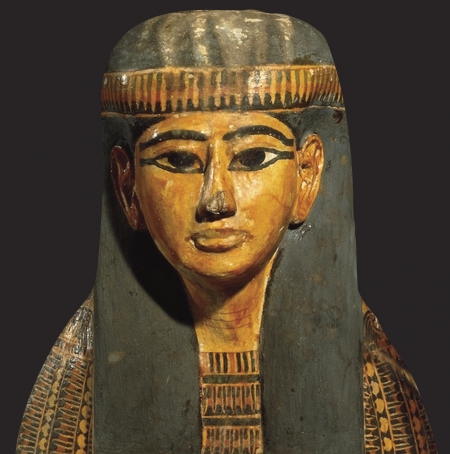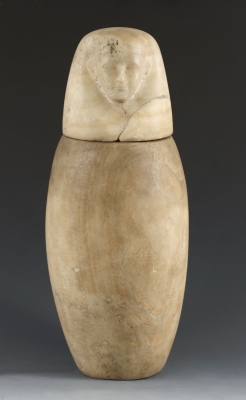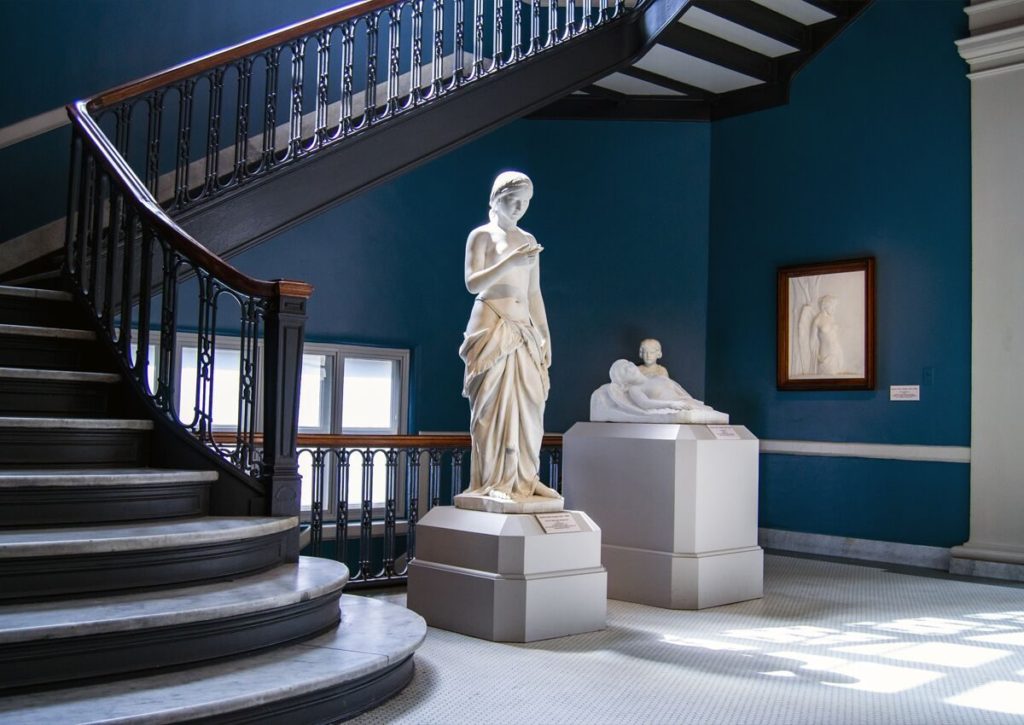Our coverage of museums, both big and small, aims to highlight collections that showcase the ancient and classical world. The museum in focus in this article is the Albany Institute of History and Art. For a small institution, its Antiquities collection is rather impressive in size and scope.
The collection spans thousands of years of Egyptian history. Most notably, it features two mummy sarcophagi, which were transported to Albany, the capital of New York State, by a certain Samuel Brown in 1909. They have since resided at the Institute, a Beaux-Arts mansion located at the city’s historic center.
The collection also features intricate amulets — ancient Egyptian funerary talismans — canopic jars, and jewelry.
In this article, we’ll cover the highlights of the Antiquities collection at the Albany Institute of History and Art — an unsuspecting treasure trove of ancient artifacts in the heart of New York’s upstate region.
Coffin Lid of Ankhefenmut

This well-preserved coffin is from the 21st Dynasty, a period of economic depression and decline in Pharaonic Egypt. So it’s impressive for such a beautiful and intricately-designed sarcophagus to emerge out of it.
There are typical ancient Egyptian religious images painted all over the coffin. These include several winged scarabs, which represent resurrection after death, “ankhs,” which symbolized eternal life in ancient Egypt, that are both free-floating and wielded by various gods, and many representations of Horus, the falcon god. Most notably, however, the goddess Nut is displayed at the coffin’s center protecting the subject, Ankhefenmut, from harm in the afterlife. Nut was the sky goddess in the ancient Egyptian pantheon, and mother to both Isis and Osiris. There is a resin coating on the surface of the coffin, which gives it a shiny appearance. The resin comes from a type of tree endemic to Egypt.
The mummy itself was found under the Bab el-Gasus, or “Gate of the Priests,” in Thebes, modern-day Luxor, Egypt. It was originally thought to be female. But, after multiple CT-scans and X-rays it was later confirmed to have been a male priest.
Head of Isis-Fortuna

Egypt became a province of the Roman Empire in 30 BC. And during this time, we start to see the syncretization of Egyptian and Roman gods. Syncretization is the combination of two or more gods from different cultures and pantheons blended into one god.
The head of Isis-Fortuna depicted here is a perfect example of syncretization.
Isis, the mother goddess of ancient Egypt, and Fortuna, the Roman goddess of good fortune and fate, were worshipped as one single goddess in Roman Egypt.
This ceramic head of Isis-Fortuna was probably connected to a small statuette intended for idol worship. The goddess is shown with a sun-disk on her head, which was a typical element used in representations of Egyptian deities.
Isis became incredibly popular on mainland Italy during the early years of the Roman Empire. There was even a cult center in Pompeii dedicated to her.
Canopic Jars

The Book of the Dead is an ancient Egyptian text that contains specific details about death and the afterlife. These include preparations for the afterlife during mummification. One of the preparations detailed in this text is the removal and storage of the internal organs of a deceased person in canopic jars.
The canopic jar pictured here shows Imsety, the human-headed son of Horus. The god also had three other sons: Duamutef, the jackal-headed, Qebehsenuef, the falcon-headed, and Hapy, the baboon-headed. Accordingly, there were four traditional canopic jars dedicated to each of Horus’s sons. Each one was intended to contain a different organ of the deceased.
The Antiquities collection at the Albany Institute of History and Art has well-preserved examples of all four of them.
Wedjat Eye Amulet: Eye of Horus

This amulet, or talisman, would likely have been used during funerary preparations. It depicts the Eye of Horus, the falcon god, son of Isis and Osiris. It’s made of faience, which is a shiny ceramic material that’s commonly found in Egyptian antiquities.
Ancient Egyptians believed that amulets were imbued with supernatural powers. And, for this reason, they were often buried with the dead. Each amulet possessed a different power, which the famed Egyptologist E.A. Wallace Budge describes in great detail in his book, Egyptian Magic.
The Eye of Horus was inspired by one of the most famous stories in Egyptian mythology. In a battle between Seth, the god of chaos and confusion, and Horus, Seth shatters Horus’s eye into six pieces. The eye represents Horus’s eventual triumph over the evil god.
Winged Scarab Amulet

The winged scarab was a very important amulet of power in ancient Egypt. This one, at the Albany Institute of History and Art, comes from either the Late Period or the Ptolemaic Period. The Late Period was the last time in ancient Egyptian history that native Egyptians ruled the country. Egypt had been in sharp decline for hundreds of years by the time of the Late Period. In fact, it had become so weakened that it was invaded and conquered by the Persian Empire during this period. The Ptolemaic Period comes right after the Late Period and is marked by Alexander the Great’s conquest of Egypt.
Scarabs were one of the most sacred animals in ancient Egypt. They were associated with eternal life. So, naturally, scarab amulets were integral to the mummification process.
After the heart of a corpse was removed during mummification, a scarab amulet would usually be placed in its void. This process was thought to protect the heart of the deceased and give him or her new life.
Practical Information: Albany Institute of History and Art

The Albany Institute of History and Art may be small, but it shouldn’t be underestimated. Ancient history lovers can spend hours studying its Antiquities collection. And, in addition to that, the museum is also home to 1,600 paintings, mostly displaying works from Hudson River School artists, and 20,000 objects collectively.
AIHA is located at 125 Washington Avenue, Albany, New York. Its hours of operation are Wednesdays – Saturdays, 10 AM – 5 PM. And from 12 PM – 5 PM on Sundays. Admission is $10 for adults, $8 for students and seniors, and $6 for children six and up.
Ancient history lovers visiting the upstate New York region won’t want to miss it.
